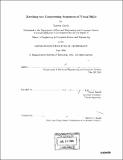Matching and compressing sequences of visual hulls
Author(s)
Goela, Naveen, 1981-
DownloadFull printable version (6.403Mb)
Other Contributors
Massachusetts Institute of Technology. Dept. of Electrical Engineering and Computer Science.
Advisor
Trevor Darrell.
Terms of use
Metadata
Show full item recordAbstract
In this thesis, we implement the polyhedral visual hull (PVH) algorithm in a modular software system to reconstruct 3D meshes from 2D images and camera poses. We also introduce the new idea of visual hull graphs. For data, using an eight camera synchronous system after multi-camera calibration, we collect video sequences to study the pose and motion of people. For efficiency in VH processing, we compress 2D input contours to reduce te number of triangles in the output mesh and demonstrate how subdivision surfaces smoothly approximate the irregular output mesh in 3D. After generating sequences of visual hulls from source video, to define a visual hull graph, we use a simple distance metric for pose by calculating Chamfer distances between 2D shape contours. At each frame of our graph, we store a view independent 3D pose and calculate the transition probability to any other frame based on similarity of pose. To test our approach, we synthesize new realistic motion by walking through cycles in the graph. Our results are new videos of arbitrary length and viewing direction based on a sample source video.
Description
Thesis (M. Eng.)--Massachusetts Institute of Technology, Dept. of Electrical Engineering and Computer Science, 2004. Includes bibliographical references (p. 61-63).
Date issued
2004Department
Massachusetts Institute of Technology. Department of Electrical Engineering and Computer SciencePublisher
Massachusetts Institute of Technology
Keywords
Electrical Engineering and Computer Science.